Up Next
A Fantastical Secret Garden Blooms in Apollinaria Broche’s New York Debut
The artist is making her New York solo debut with "In the Distance There Was a Glimpse" on view at Marianne Boesky, New York.
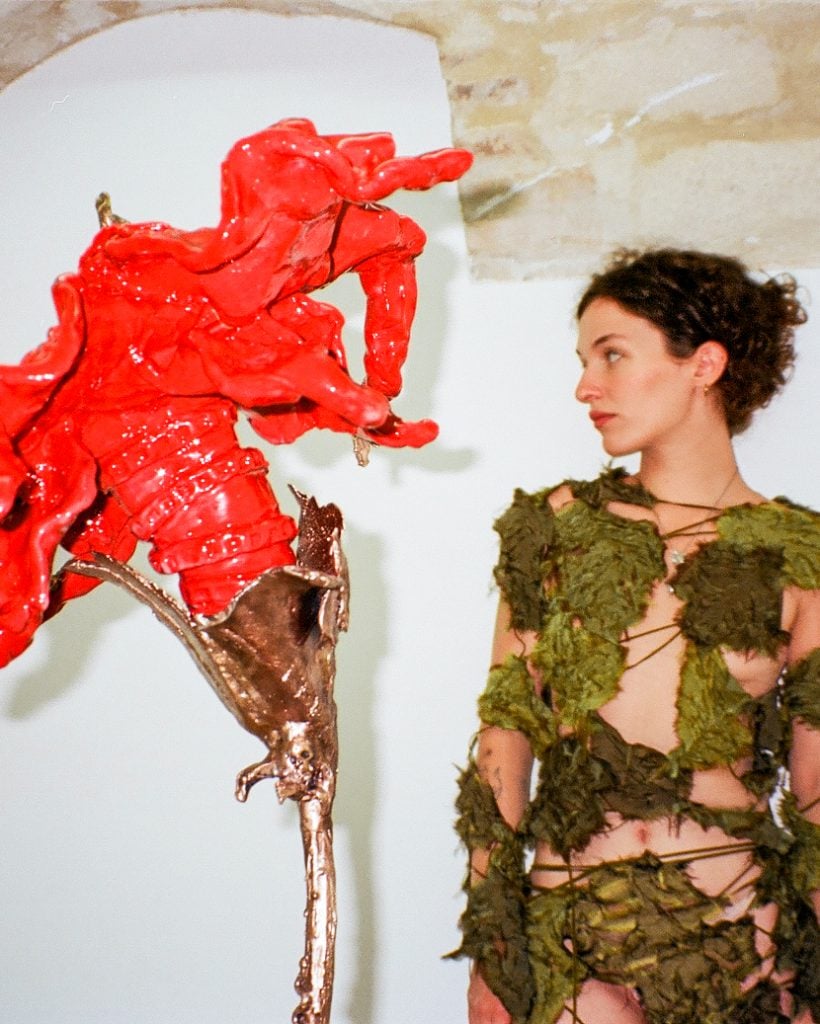
The flowers are crying, and smiling, and even dancing (for a moment) as the artist Apollinaria Broche lightly pushes against one of her fantastical blossoms installed at Marianne Boesky Gallery in Chelsea. The sculptures, which stand at about the height of a grade school child, are made up of glazed, magnificent plate-sized ceramic blossoms with bronze, winding stems. When they’re touched, some of the sculptures shimmy energetically back and forth for a moment in kinetic bliss. Adornments—keys, daggers, relic-like charms—dangle from the flowers and stems, and make them seem like statues of saints or warriors laden with symbolism and history.
“Where I’m working now in Italy there is a greenhouse full of flowers,” the 29-year-old artist Franco-Russian artist said, a twinkle in her eye as we walked through “In the Distance There Was a Glimpse”—Broche’s transportive New York solo debut at Marianne Boesky Gallery (on view through February 25).
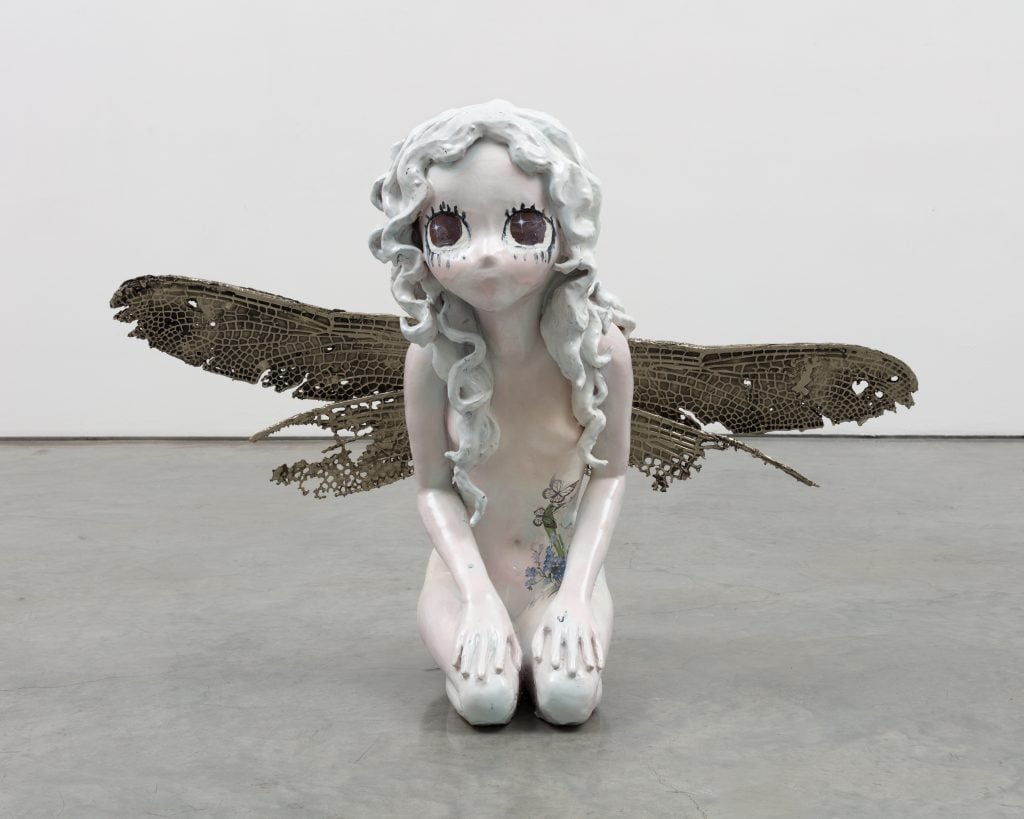
Apollinaria Broche, Fade Into You, Strange, You Never Knew (2023). © Apollinaria Broche and courtesy of Marianne Boesky Gallery. Photograph by Lance Brewer.
Meandering through Broche’s exhibition is like walking into an enchanted garden, a world where magic and myth unfolds. Sculptures of lovers, fairies, and chimeras fill the gallery with a sense of whimsy. Yet, one realizes quickly, this is not a garden without traps and tricks: coiled snakes, demons, and cloaked daggers are hidden in plain sight.
Broche, who was born in Moscow in 1995 and now works between Paris and Pietrasanta, Italy, has been refining unique visual vocabulary for the past several years. In Europe, her works have been widely exhibited including at Island in Brussels, ENSBA in Paris, and Triumph Gallery in Moscow, among others. She’s also exhibited and studied at Otis College of Art and Design in Los Angeles. Broche has garnered growing attention with these shows and in 2022, she was invited to collaborate on a project with Acne Studios for their AW 2021-22 collection, resulting in ceramic sculptures and jewelry. But her New York debut marks a moment of arrival for the artist, and she knows it.
“When I was a kid people in arts and culture were always saying I should go to New York. When I was 13, I told myself I would only come to New York with a big project” Broche recalled, “It was getting ridiculous for me to avoid this city for years. but then Marianne [Boesky] came for a studio visit with me in Italy and soon offered me the show, it’s all aligned.”
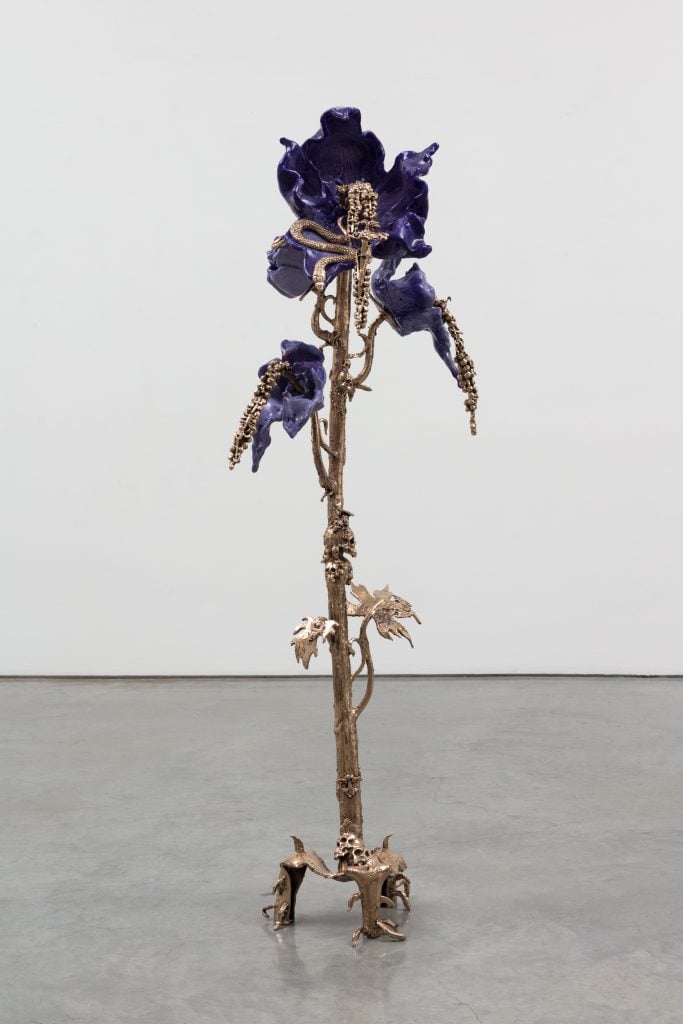
Apollinaria Broche, hid my tracks Spit out all my air (2023). © Apollinaria Broche and courtesy of Marianne Boesky Gallery. Photograph by Lance Brewer.
“In the Distance There Was a Glimpse” is a full-throated introduction to Broche, charting her practice over the past few years. This is a fantastical world that weaves together references to myth, war, violence, children’s books, music, and anime with a lightness of spirit that is invigorating and poignant at the same time. New works, never before seen, blend bronze and ceramic in single compositions. The skill is the result of Broche immersing herself in a centuries-old artist colony in Pietrasanta for nearly two years. The unlikely union of these materials hints at recurring themes: nightmares and dreams, fantasy and reality, the fragile and the resiliently strong.
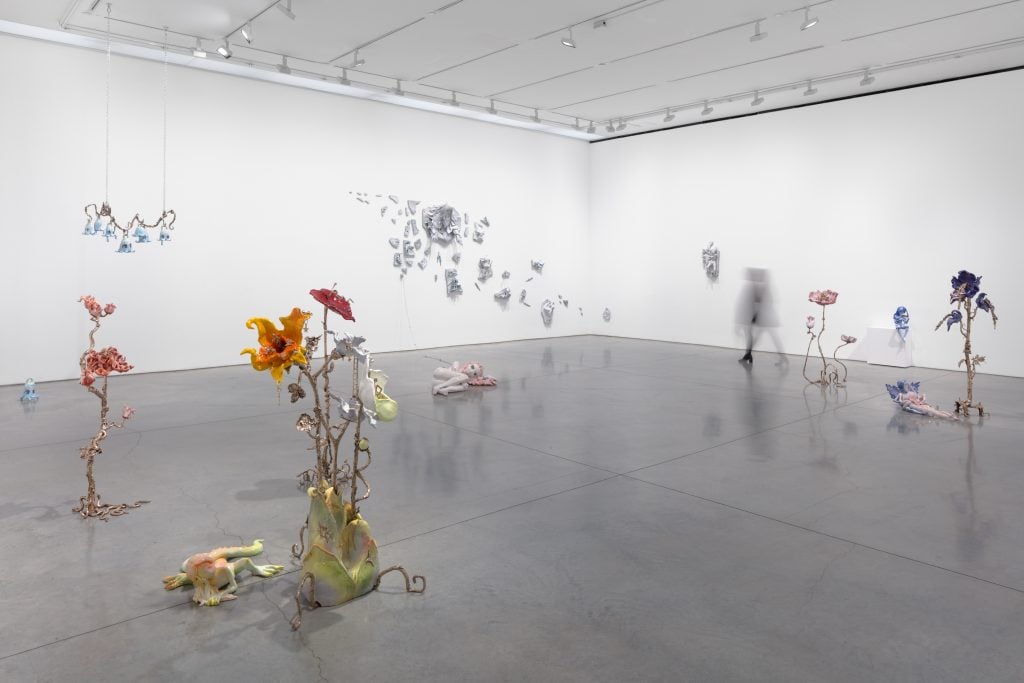
Installation view “In the Distance There Was a Glimpse” 2024. © Apollinaria Broche and courtesy of Marianne Boesky Gallery. Photograph by Lance Brewer.
The earliest work in the exhibition is a sprawling sculptural installation, The Peace Room Is Closed for Renovation—her artistic response to the 2022 invasion of Ukraine.
“I’m half Russian, half French. My grandpa is Ukrainian. Many of my friends in Paris are Ukrainian. This experience was mind-blowing for my heart and soul. I stopped making art for eight months for the first time in my life. I was protesting and, in Paris, I was looking to find housing for people who were arriving. I had relatives, aunts, and cousins, coming. It became a full-on job,” said Broche, “But then a friend of mine from Kyiv said that I needed to remember my purpose, which is to speak out all the pain.”
Immersing herself in artmaking, Broche relocated to Italy for her residency. There she undertook a kind of artistic pilgrimage to Siena intending to see an artwork she had long admired: Ambrogio Lorenzetti’s fresco The Allegory of Good and Bad Government which is painted on the walls of Sala della Pace (or Peace Room), the seat of the city’s 14th-century government. In the fresco, good government is depicted with Justice presiding over a world of order and prosperity. In the imagery of bad government, Justice is shown blindfolded, bound, and chained amid a world of war. It’s an unusual image for its time, political and not a bit religious.
Upon her arrival at the Sala della Pace, however, a closed door greeted Broche and a sign that read “The Peace Room is closed for renovation.” The experience led Broche to visualize her own version of “bad government” seen in The Peace Room Is Closed for Renovation (2022) In the ceramic installation, fragmented forms of weapons, broken bricks, and monstrous beings line the gallery walls in a shrapnel-like explosion. A hooded, ghost-like figure looms over this scene of destruction, like a faceless force of evil. There is also a bronze chain mounted to the gallery wall which is shackled to the wrist of a ceramic fairylike creature who has huge anime eye. The fairy lies on the floor, wounded, her torso cracked and patched with clay band-aids, a bound and bruised Justice for our times.
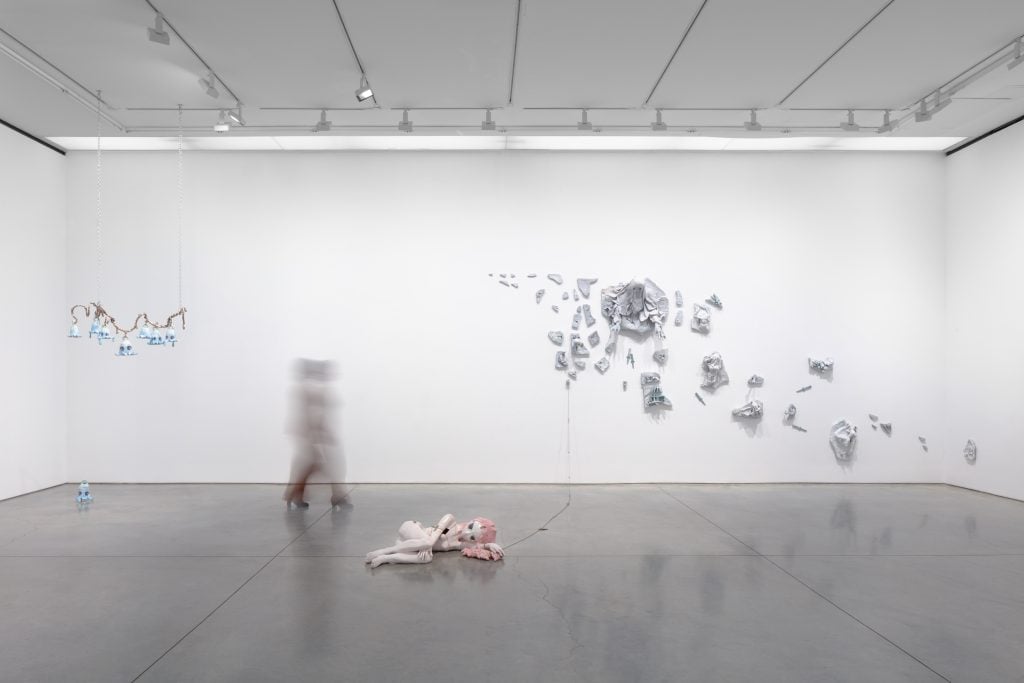
Installation view “In the Distance There Was a Glimpse” 2024. © Apollinaria Broche and courtesy of Marianne Boesky Gallery. Photograph by Lance Brewer.
“Justice has cracks running through her after all these years. But I don’t want to hide these cracks. Clay, like us, is fragile. We don’t need to hide these marks but heal them, which is why she has Band-aids on her body,” said Broche, “I want people to feel a sense of warmth, and that maybe we can help her to slowly stand up.”
These essential forces—truth, justice, evil, and beauty—loom largely in Broche’s works, which ask viewers to reimagine how we might imagine these abstract forces within our visual culture as well as in our inundated contemporary lives. For Broche, the world of fantasy and children’s literature as a way to navigate a strange and often treacherous world.
In fact, the exhibition title “In the Distance There Was a Glimpse” is a line from Frances Hodgson Burnett’s 1911 enchanting children’s novel The Secret Garden, in which a young orphan girl discovers a magical garden on her uncle’s estate. The girl, Mary, awakens in her unfamiliar new room. “The walls were covered with tapestry with a forest scene embroidered on it,” Burnett wrote, “There were fantastically dressed people under the trees and in the distance, there was a glimpse of the turrets of a castle. There were hunters and horses and dogs and ladies. Mary felt as if she were in the forest with them.”
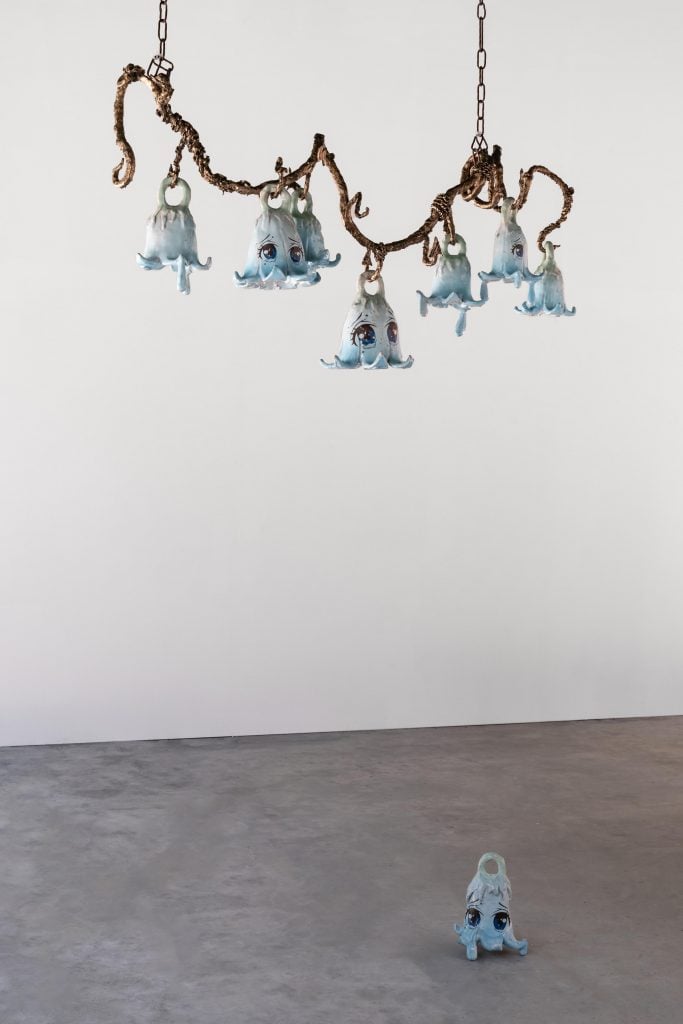
Apollinaria Broche, Teardrops Are Falling 2023). © Apollinaria Broche and courtesy of Marianne Boesky Gallery. Photograph by Lance Brewer.
This sense of imagination, and kinship with the inanimate world, suffuses the exhibition. Various flowers offer new emotions and reactions. “Since childhood, I’ve been fascinated by the language of flowers, the symbols in Alice in Wonderland,” said Broche, “I did a lot of research into art history and the meanings flowers have held over time. A pink rose is about the presentation of the ego. I thought straight away of the Little Prince, the fragility of the ego, and so on.” In Broche’s most recent flower sculptures, large, deeply colorful ceramic blossoms draw viewers in, but closer examination reveals snakes and skulls, symbols of evil and death, upon the flowers themselves.
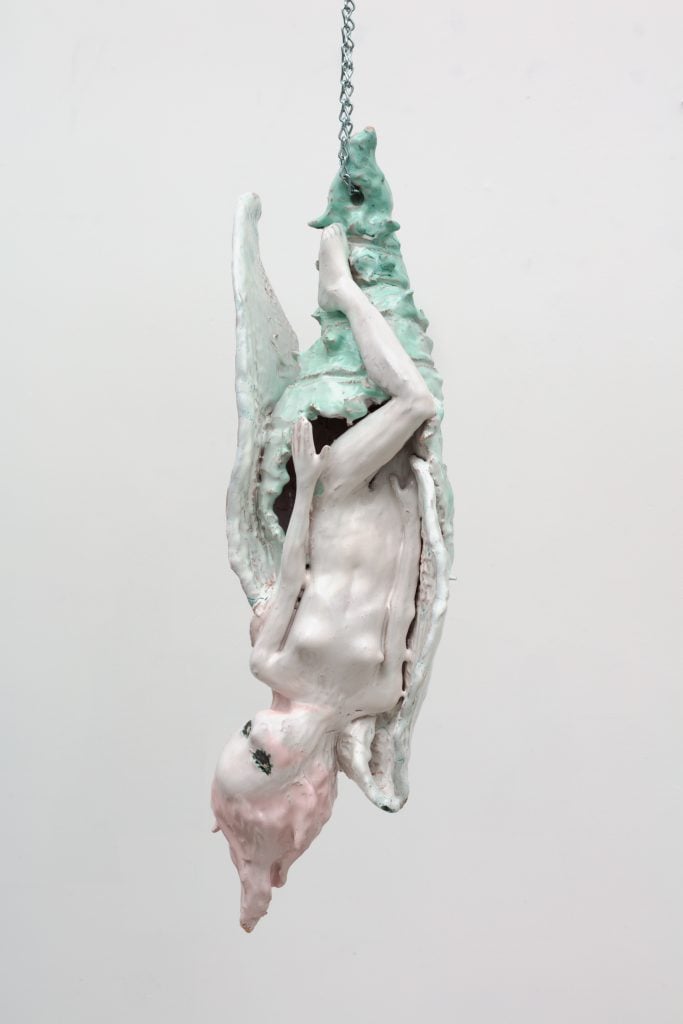
Apollinaria Broche, Still get those stupid belly butterflies (2023). © Apollinaria Broche and courtesy of Marianne Boesky Gallery. Photograph by Lance Brewer.
The trials and triumphs of these fairies and flowers are veiled lessons about the complexities of our own world, and suggest that beauty still lives amid pain. Still, there is always a calling toward self-actualization nearby, a call for a better world. In the sculpture Still get those stupid belly butterflies, a fairy emerges from a chrysalis—like many of the works in the show, this butterfly being is a reminder of our ability to reimagine and transform ourselves and the world around us.





